Our exhibition, Never Broken: Visualizing Lenape Histories, was held at the James A. Michener Art Museum in Bucks County, Pennsylvania from September 9, 2023 to January 14, 2024. The first room featured a salon-style hang of prints, paintings, and textiles incorporating images of Penn’s Treaty, also known as the Treaty of Shackamaxon, made after Benjamin West’s iconic painting Penn’s Treaty with the Indians (1771-72) (Fig. 1). A framed, printed bed curtain replicating West’s scene, a needlework picture by the British artist Margaret Ansell, and versions of Penn’s Treaty by the Bucks County painter Edward Hicks (1780–1849) filled one wall (Fig. 2). The close hang of these artworks, displayed behind a porcelain cup and saucer also reproducing the subject, emphasized the virality and persistence of this image in the media landscape and domestic interiors of settler colonists in North America in the late eighteenth and early nineteenth centuries.

West’s Penn’s Treaty, along with its many copies and appropriations, is one of the most well-known visualizations of an encounter between Native Americans and European colonists. What made this image significant in our exhibition was its local ties to our museum in Bucks County. The work depicts William Penn, the founder of the Province of Pennsylvania, his agents, and merchants trading cloth and other goods for land from the Lenape, the region’s historical inhabitants. Commissioned by William Penn’s son, Thomas Penn (1702-75), to celebrate the achievements of his father, Penn’s Treaty established a visual record for an event with limited documentation that occurred over a century earlier. It is therefore a perspective on history, not a factual account.
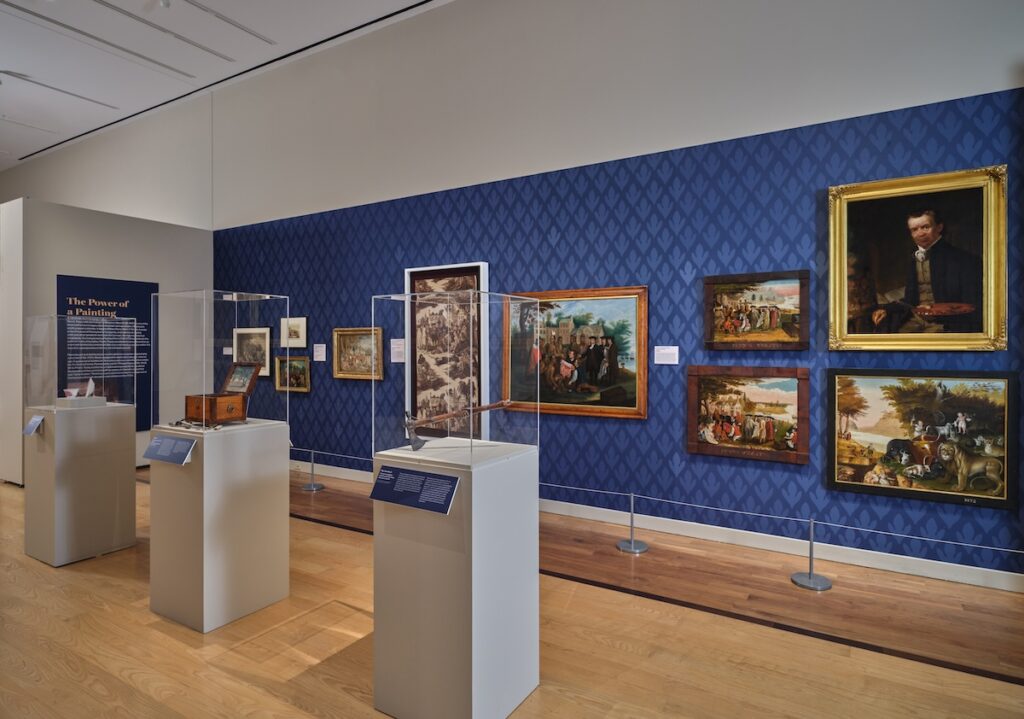
Reproduced and distributed across the globe as a popular engraving by John Hall (1739–97), West’s composition went viral in the pre–internet age, broadcasting a fictitious vision of a peaceful land succession at a moment when the Lenape population had been decimated through introduced diseases, massacres, and forced removals by European colonists eager to claim land. While some Lenape fled northwest to Canada and Wisconsin, the majority of the Lenape people were forced to relocate to western Pennsylvania and Ohio, then west to Indiana, southern Illinois, Kansas, Missouri, and, finally, Oklahoma. Today, there are five federally-recognized tribes of Lenape descendants: Delaware Nation and Delaware Tribe of Indians in Oklahoma, the Stockbridge-Munsee Community in Wisconsin, and, in Ontario, Canada, the Munsee-Delaware Nation, Moravian of the Thames First Nation, and Delaware of Six Nations. While there are groups in Pennsylvania that claim Lenape ancestry, there are currently no state- or federally-recognized tribes in Pennsylvania. Despite obscuring this vital history of the Lenape, Penn’s Treaty is such a persistent image that it appears in social studies textbooks taught in our local Bucks County schools today.
Never Broken sought to underscore the power of art to create, challenge, and rewrite the history that Penn’s Treaty tells through a dynamic display of contemporary art by Lenape (also called Delaware) artists in conversation with historic ceramics, beadwork, and artwork by European American artists. It was the first exhibition of Native American art organized by the Michener Art Museum, and we also believe it is the first exhibition of contemporary Indigenous artists to feature Lenape artists exclusively. Recent and newly commissioned work by artists Ahchipaptunhe (Delaware Tribe of Indians and Cherokee), Joe Baker (Delaware Tribe of Indians), Holly Wilson (Delaware Nation and Cherokee), and Nathan Young (Delaware Tribe of Indians, Pawnee, and Kiowa) expressed personal and tribal identity and addressed the Lenape’s violent displacement from Lenapehoking, the Lenape homeland which encompasses the region where the Michener Art Museum currently stands. Their work underscored the continuing legacy and evolution of Lenape visual expression and cross-cultural exchange, reasserted the agency of their Lenape ancestors, and established that the Lenape’s ties to the area were never broken.
When preparing for this exhibition, Michener staff continually asked: how can we critically unpack the myth-making that has been perpetuated within the visual imagery of our region in Pennsylvania? The invented history of a peaceful transfer of land as depicted in Penn’s Treaty has always been both sticky and pervasive. Prints, textiles, paintings, and decorative arts featuring Penn’s Treaty circulated when the United States secured its independence from the British, therefore offering an appealing but misleading creation story for a new nation seeking to write its own history. In our exhibition planning, we asked: how can we prioritize Lenape voices in the telling of this history? These questions and concerns came through in the exhibition’s design as well as its content. The Penn’s Treaty images were hung on a wall covered in a wallpaper designed by Director of Exhibitions Joshua Lessard, with a repeating pattern of sassafras leaves, a plant that is significant to the Lenape, subtly reasserting Lenape agency even within the focus on Penn’s Treaty in this section.
Never Broken was ground-breaking and transformative for the Michener, which has not historically considered Indigenous art as central to its mission. Founded in 1988 in the former Bucks County Jail in Doylestown, Pennsylvania, about an hour outside of Philadelphia, the Michener collects, preserves, interprets, and exhibits art, primarily American art, and promotes the Delaware River Valley region’s rich artistic and cultural heritage, with a particular focus on Bucks County. While the museum’s art collection and exhibition program has spanned the nineteenth century to the present day, the Michener is primarily known for its significant holdings of landscape paintings by Pennsylvania Impressionists, predominantly white artists who fled increasing industrialization and immigration in urban centers and settled along the Delaware River around New Hope, Pennsylvania in the early twentieth century. The museum does own and display sculpture by Allan Houser (Apache) and Doug Hyde (Assiniboine, Nez Perce, and Chippewa), but the Michener, until recently, did not own any contemporary or historic work by the Indigenous people of its region, the Lenape. This visual expression had previously been omitted from the institution’s narrative of regional art history. Indeed, this omission was not unique amongst peer museums with a similar size and budget, whose regional focus similarly did not encompass Indigenous artists. In the last couple of years, however, there has been a groundswell of commitment to working with Indigenous partners and artists in site reinterpretations and exhibitions. Pennsbury Manor, William Penn’s colonial estate, for example, recently commissioned an immersive sound installation, nkwiluntàmën: I long for it; I am lonesome for it (such as the sound of a drum) by Nathan Young, who also exhibited in Never Broken. nkwiluntàmën amplifies Indigenous agency at Penn’s estate through a reimagination of environmental song-making traditions of the Lenape’s diaspora.
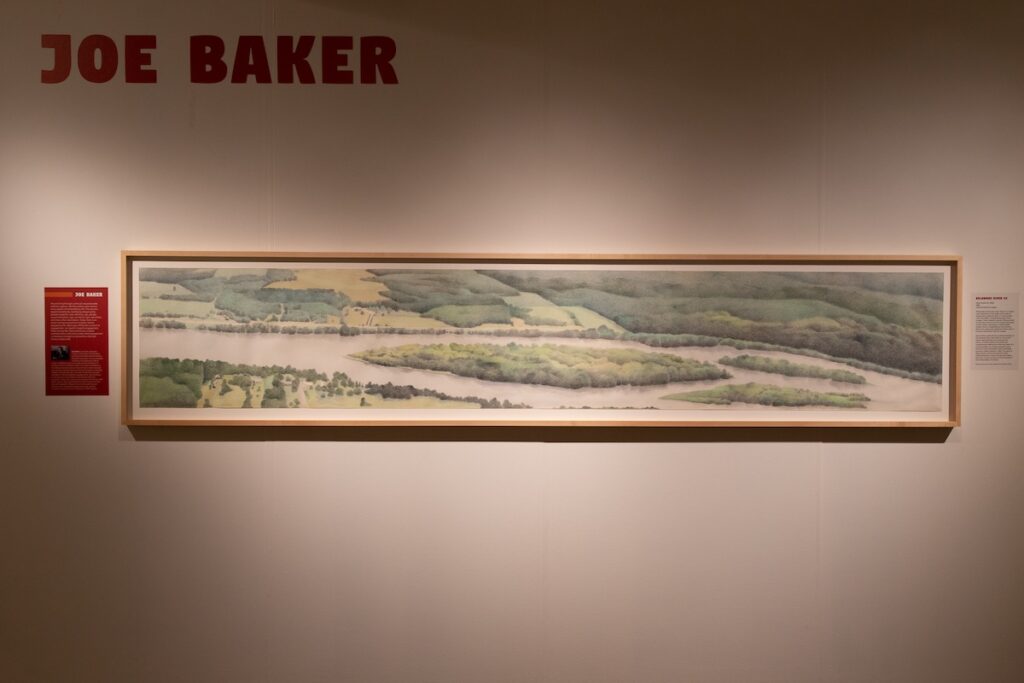
Following conversations with peers at other Philadelphia-area institutions, like the Philadelphia Museum of Art and Penn Museum, who recently collaborated with Lenape partners on exhibitions and gallery reinstallations, Gerry and Marguerite Lenfest Chief Curator Laura Turner Igoe and Joshua Lessard connected with Joe Baker, an artist, curator, and former museum director of Mashantucket Peaquot Museum in Connecticut and the Palos Verdes Art Center in Los Angeles. Joe is also the co-founder and current director of Lenape Center in New York, a nonprofit art and culture organization founded in 2009 that has been working to push back against the erasure of Lenape people, their stories, and their histories through exhibitions and programs in the ancestral homeland. The Michener first worked with Joe as a guest curator for our 2022 exhibition Reframe: Community Perspectives on the Michener’s Art Collection, in which the museum invited community members and interdisciplinary scholars to select artworks from its collection to tell new stories about identity and the environment in the greater Delaware Valley. Joe chose a panoramic, colored pencil drawing, Delaware River #2, by Diane Burko (Fig. 3). In his accompanying label, Joe explained the significance of Lënapei Sipu, the Delaware River, to the Lenape and drew attention to what Burko’s drawing does not depict: the historic genocide of the Lenape that occurred upon the river’s shores. While collaborating on Reframe, we began discussing an exhibition that would critically unpack the myth-making inherent in Penn’s Treaty artworks and foreground work by historic and contemporary Lenape makers and artists that challenge these narratives and tell their own histories.
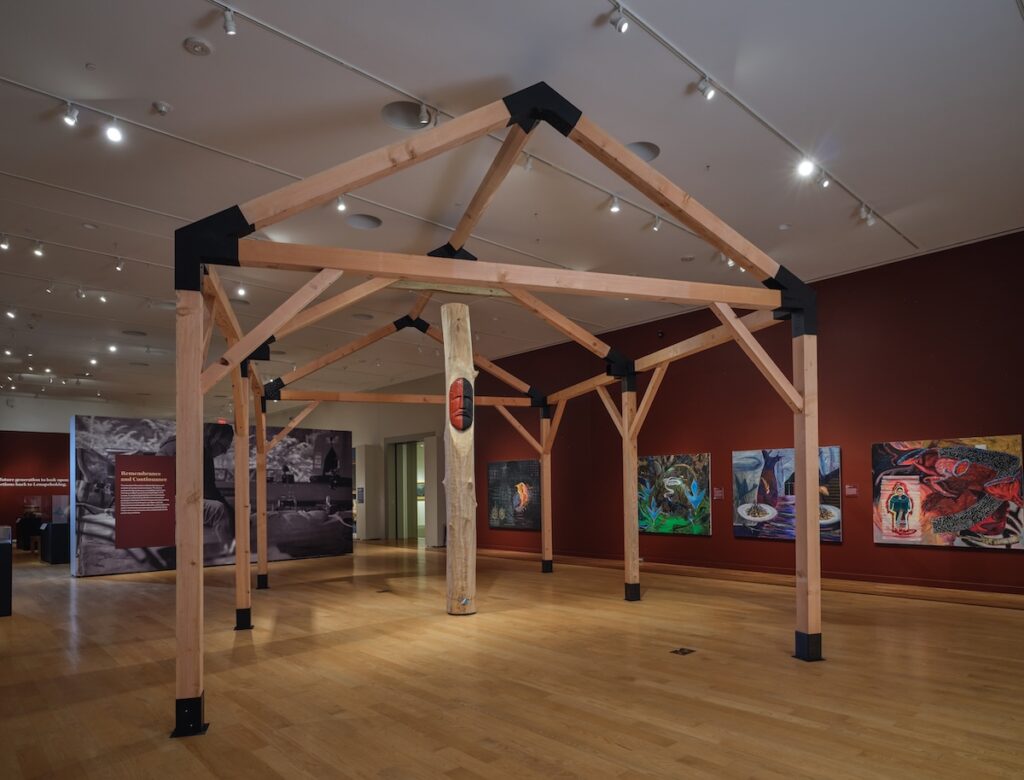
In the largest section of Never Broken, titled Remembrance and Continuance, artworks by Joe Baker and Holly Wilson countered the European American vision of peaceful succession of land by the Lenape with paintings, sculpture, and an installation that broadcast the legacy and evolution of Lenape visual expression (Fig. 4). This gallery was anchored by Remembrance, described by Joe Baker below:
Remembrance is inspired by elements that inform the Xiniwikaon, or the Big House, the traditional religion of the Lenape. The people gathered in the fall for a period of twelve days to give thanks to the Creator and create balance and harmony in the world. The ceremony was performed in a rectangular house featuring a center post and two fires. It was here that songs and visions were shared around a circular dance path which held the footsteps and heartbeats of the people. This was the path to all that is beautiful and possible, connecting present and past generations through space. The fires maintained the balance and harmony. The center post was the cosmic tree that reached up through the multilayered universe (12 levels) to the highest level. The pathway or dance circle, representing the Milky Way, provided access to the unseen and the visible. It did not end; it remains to be seen.
The Big House ceremony was last held northwest of Copan, Oklahoma, in 1924. Revived briefly during the period of World War II, it was then “put away” by direction of Tribal Elders. The act of “putting away” has many different interpretations. One can “put away” for safekeeping or other reasons. It does not necessarily mean “end” as held by some community members. What has been put away can also be brought back into existence. It was in this spirit that Remembrance was created for the exhibition at the Michener Art Museum. The center post of bigtooth aspen was gathered near Accord, New York, in the spring of 2023. The felled tree had been sustained by a grove of neighboring ash trees that were protecting the less stable aspen. As the ash trees gave way to disease, the aspen trees were exposed to winds and environmental threats. Transported from the forest floor to an outdoor studio, the post was prepared for carving. Traditional carving, once common in our community, is no longer in practice. The project served the purpose of not only remembering but also returning an art form. I recently heard a community member refer to carving and other art-making practices as “crafting.” The activity or hobby of making decorative articles has no application in the creation of traditional art used within the ceremonial practices of Indigenous communities. It is Lenape Center’s hope that installations such as Remembrance will bring about a renewed appreciation and value to Lenape aesthetics by both Tribal members and the greater public.

Surrounding Remembrance were four paintings also by Baker—Three Sisters, The Big House, Doll Dance, and Stomp Dance—that honor the artist’s ancestors and include layered, visual references to Lenape ceremonies and dances. Holly Wilson’s monumental sculpture Bloodline, which the museum acquired for its permanent collection, tells a powerful and complicated story of loss, survival, and resilience through a series of bronze figures representing multiple generations of the artist’s family traversing a cut locust tree (Fig. 5). These works carry stories from the Lenape’s past into the present day and future.

A display of historic and contemporary Lenape beadwork in the same gallery illuminated how Lenape designers incorporate new materials and techniques from other cultures into their creative expression (Fig. 6). This section featured two nineteenth-century bandolier bags from a private collection and the Brooklyn Museum. Primarily worn in a cross-body fashion by men for special occasions, these bags showcased colorful, embroidered strands of tiny glass beads (sometimes called seed beads) manufactured in Venice and acquired from European traders. The bandolier bags combined Lenape traditions with those from other displaced Native peoples after the Indian Removal Act of 1830 forced the majority of the Lenape to relocate to Oklahoma. After learning that white collectors had removed many historic bandolier bags from his Delaware Tribe community, Joe taught himself how to make these beaded bags, combining traditional Lenape forms, like abstract flowers and leaves, with more personal symbols and motifs, in order to bring this art form back to the Delaware Tribe. Three of Joe’s bandolier bags were on display on mannequins in the exhibition.
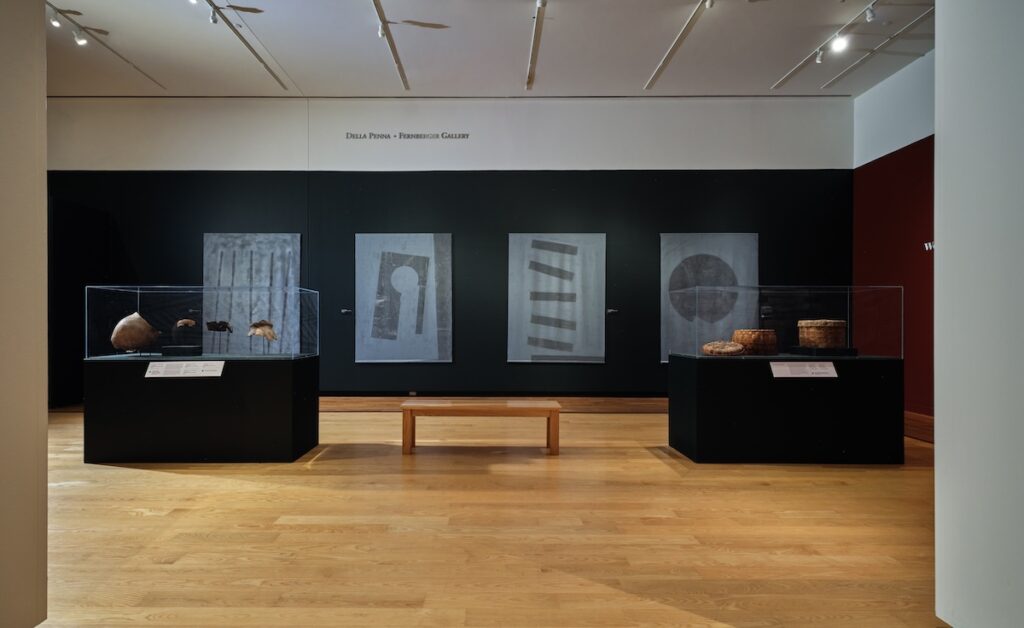
In the Impressions of Lenapehoking section, Ahchipaptunhe made four, large-scale, unstretched canvases in response to incised Lenape ceramic vessels used over 1,000 years ago and stamped baskets made for trade with European settlers, also displayed in the gallery (Fig. 7). To create his paintings, Ahchipaptunhe pushed paint across primed cotton on the ground and allowed it to spread and pool into the fabric’s indentations and cracks. While the paint was drying, he impressed geometric forms using carved potatoes, broken tree limbs, and other items into the damp surface, like a potter incising decoration into a ceramic vessel or an artist stamping designs onto a basket. Named after the four elements in the Lenape language—Tëntay – Fire; Lexeokàn – Breathing; Niskëpèk – Dirty Water; and Hàki – Earth, Dirt, Ground or Soil—these paintings articulated the interconnectedness of these objects with the natural world. Ahchipaptunhe explained that he sought to honor these past makers in his artistic voice: “A reminder that we are still here, forging paths for a future generation to look upon and see their connections back to Lenapehoking.”
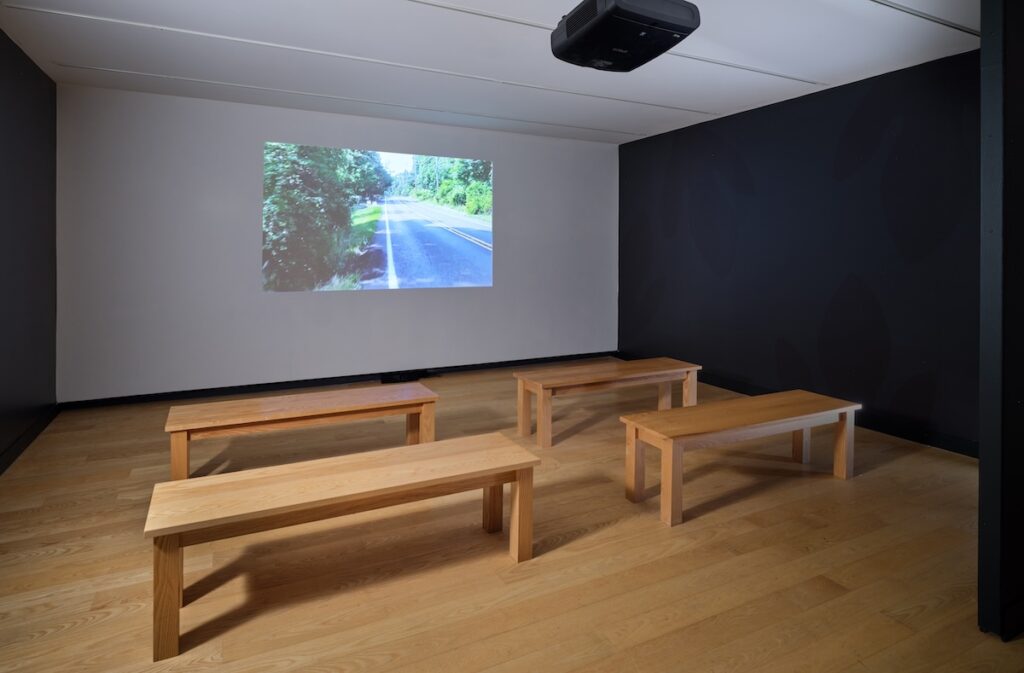
Finally, a video and sound piece by Nathan Young explored and visually unmade the infamous Walking Purchase of 1737, in which colonists swindled 1.2 million acres of land from the Lenape (Fig. 8). William Penn’s sons, who were then the Pennsylvania colony’s proprietors, coerced Lenape chiefs to confirm an incomplete deed from 1686 that outlined the transfer of land measured by a walk of one and a half days. After clearing a path in advance, three fast runners sped from modern-day Wrightstown to Jim Thorpe, Pennsylvania, traveling sixty-four miles in eighteen hours and covering much more territory than the Lenape had anticipated. Alëmi pëmëske (He begins to walk) records Young and artist Yatika Starr Fields traveling eighteen miles of modern roads on foot from Ottsville, Pennsylvania, where one of the “walkers,” Solomon Jennings, dropped out, to the starting point of the original walk at Wrightstown Friends Meeting. The ominous soundtrack and the monotonous passing of cars and trucks warns of the challenges and hardships that Young’s ancestors faced as they were forced from their homeland following the Walking Purchase.
A reflection space in the exhibition provided an opportunity for visitors to hear directly from the artists explaining what Lenapehoking means to them and what they hope visitors will take away from the exhibition through audio recordings accessed via QR codes. Additional audio recordings of the artists explaining their work were included throughout the exhibition and are still available on the Michener’s YouTube page. A panel discussion with Joe and exhibiting artists, also available online; gallery talks by Joe; and a presentation and family program by Holly Wilson further ensured that artist perspectives activated the exhibition throughout its run. The exhibition lives on in an illustrated catalogue, distributed through University of Pennsylvania Press, that includes installation images and essays by Joe Baker, Laura Turner Igoe, and Joel Whitney. As part of the exhibition’s development process, staff wrote and implemented a living land acknowledgement with the assistance of Lenape Center that recognizes the Michener’s location within the ancestral and spiritual homeland of the Lenape and states the museum’s commitment to “learn from Lenape culture and provide a space for their current perspectives in our work.” Joe Baker recorded a final message for our visitors with the hope of how this exhibition might change the way they see our local landscape:
I would hope that the visitor to this exhibit would be inspired to know more, to know more about the history… of the place in which they live, the place that they move around every day as they go to and from work, to and from the store, the place that really holds them up, that gives them community. What was the true history of their place, what happened in this place and how can we, through understanding that true history, create a better place for the future, a place that is inclusive, a place that is respectful of those people and those lives that have come before us, a place that is mindful of the sacrifice and the challenges of a very real genocide that the world has yet to really comprehend. What happened here on these soils has never really been told and it is the foundation of what we understand today as the United States. It all happened here, it all began here, particularly for those who lived so close to the beginning of this country. I think it’s important that we reset, recalibrate our perspective and come face-to-face with a true history.
Laura Turner Igoe, Ph.D. is the Gerry and Marguerite Lenfest Chief Curator at the James A. Michener Art Museum
Joe Baker is an enrolled member of the Delaware Tribe of Indians and co-founder and executive director of Lenape Center in New York
Cite this note as: Joe Baker and Laura Turner Igoe, “Curators’ Notes: Never Broken: Visualizing Lenape Histories – by Joe Baker and Laura Turner Igoe,” Journal18 (June 2024), https://www.journal18.org/7361.
License: CC BY-NC
Journal18 is published under a Creative Commons CC BY-NC International 4.0 license. Use of any content published in Journal18 must be for non-commercial purposes and appropriate credit must be given to the author of the content. Details for appropriate citation appear above.
